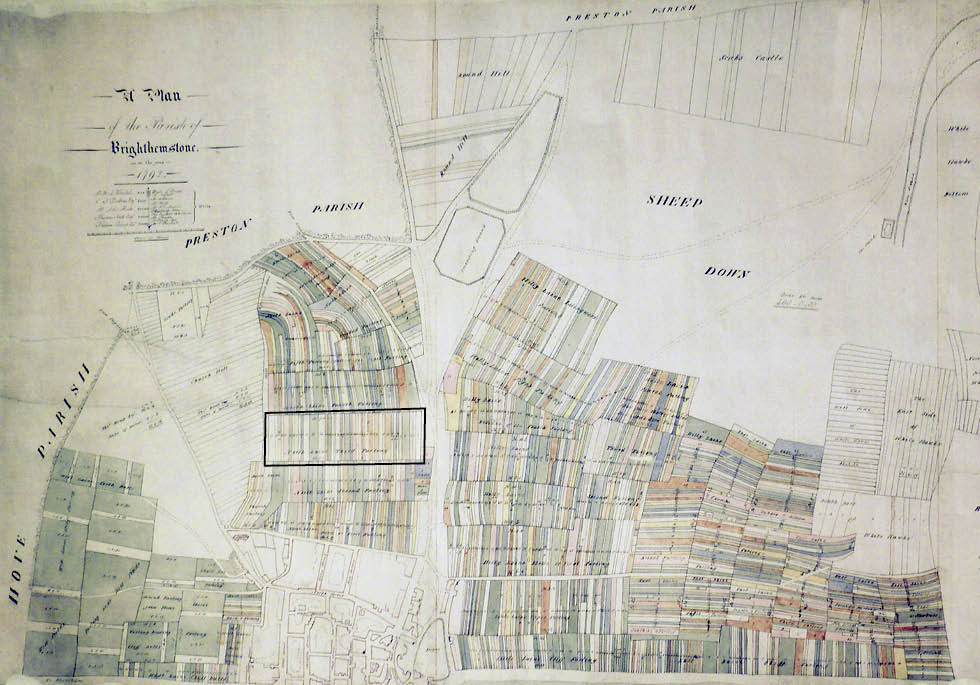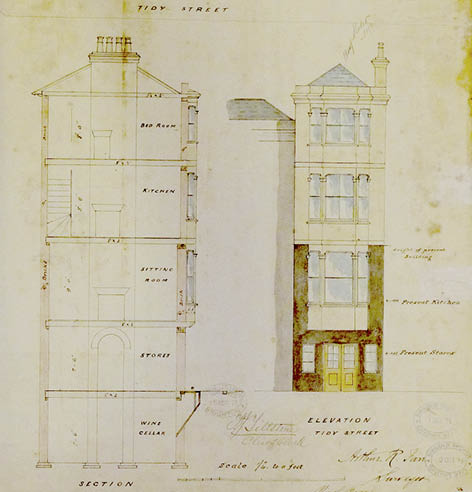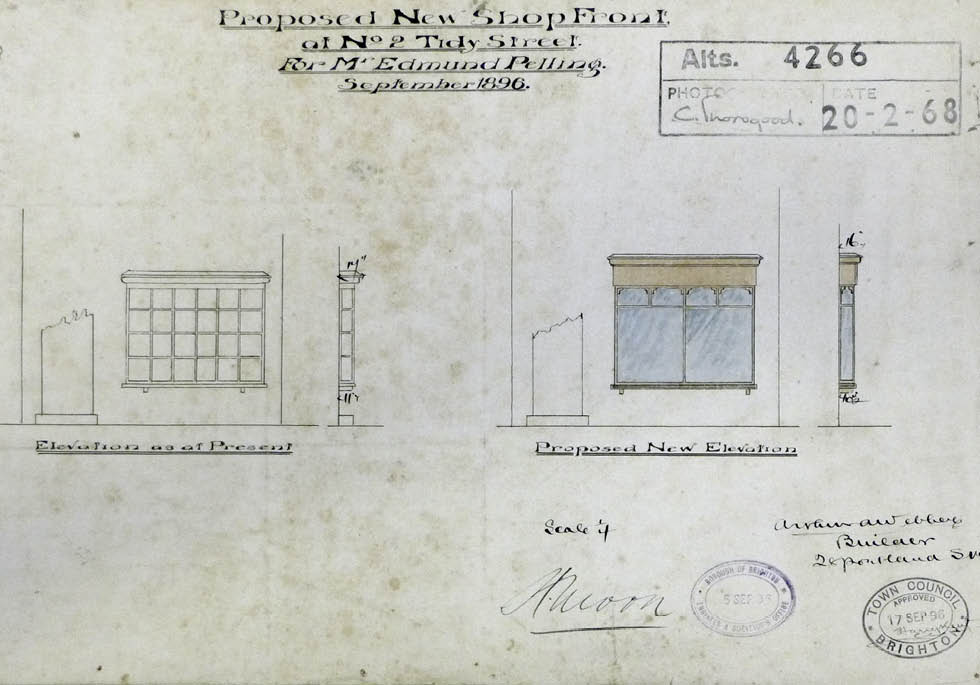Street history - Tidy Street
Lead researcher Phyllis McDonald
Download the Tidy Street history as a .pdf (1.5Mb)
Introduction
This is the story of Tidy Street in the North Laine area of Brighton. The street is built on two strips of ancient open-field arable farming land: one of these was 4 pauls in size and the other was 8 pauls. We had no knowledge of what was grown on the land but we know that, by the 1830s, when building started, both of these pieces of land had passed into the ownership of John Whichelo. The land was “part of 4 pauls formerly Benj. Scutts late Harmans and 8 pauls, formerly Benj. Master’s, situate in the 3rd furlong North Laine.” These can be seen in the 1792 “Terrier” - the official record held by the manor of Brighton-Lewes - and it is possible to track the changes in the copyholders. Benjamin Scutt’s 4 pauls passed to Charles Scrase and, by 1793, to his grandson Charles Scrase Dickins. In 1822 Charles Scrase Dickens sold the land to Thomas Attree who then sold it on in 1823 to John Whichelo for £140. Benjamin Master’s 8 pauls had passed to his nephew Richard Tidy in 1750 and on his death, in 1788, to Richard Lemmon Whichelo from whom it passed to Elgate Whichelo in 1800 and on his death, within months, to his brother John Whichelo.1
Tidy Street runs north to south between Trafalgar Street and Gloucester Road. Downhill to the east is Sydney Street and uphill to the west is Kensington Place.
The name of Richard Tidy appears often in the lists of copyholders in Brighton. In 1755 he inherited property from his uncle, Richard Masters and this included one of the pieces of land which was used to create the street.2 He was described as a merchant living at Cliffe, near Lewes, but he had many business interests in Brighton. In 1757 he became the owner of the White Lion in North Street (opposite West Street), the building dated at least from the Sixteenth Century and it was probably Tidy who turned it into an inn which became notable for cockfighting.3 Like Richard Whichelo he was one of the first Commissioners for Brighton formed under the 1773 Brighton Town Act.4
1) Terrier map of Brighton, 1792 (Third Furlong here shown framed). Image courtesy of East Sussex Record Office. Enlarge
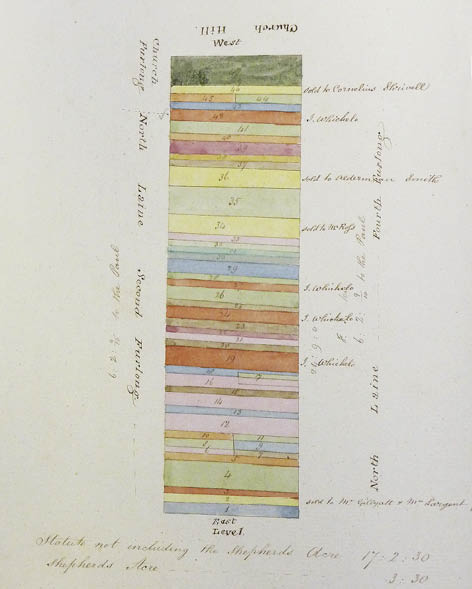
2) Close up of the Third Furlong, 1792. Image courtesy of
East Sussex Record Office
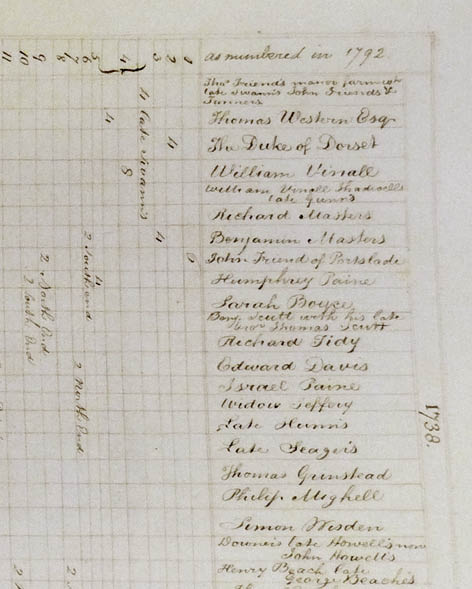
3) Detail from the 1792 Terrier’s apportionment list showing
landholding interests in Tidy Street. Image courtesy of East
Sussex Record Office
Development
For most of the 18th Century Brighton had been a town of 2-3,000 people. Following its adoption by the Prince Regent and its continued development as a sea-bathing centre, the population rose to 5,669 in 1794 and to 7,339 in 1801. In 1811 it was 12,012 but that had doubled (to 24,429) in 1821 and by 1831 it was 40,634.5 This population increase saw John Whichelo and his fellow businessmen engage with the great early-19th century building boom which gradually covered all of the old open arable fields with streets of small houses. They knew that the arrival of the wealthy meant the arrival of an army of servants, tradesmen and artisans to supply their needs.
In Tidy Street, John Whichelo worked with Robert Chalcroft, a builder. Land at the south end was sold to Robert Frampton, who built and occupied what was to become 101 Gloucester Lane (later Gloucester Road) and number 1 Tidy Street.6 Robert Frampton appears to have built the property (or messuage) to live in himself. There are no details of the rest of the street but in 1835 Whichelo and Chalcroft sold number 4 Tidy Street to Robert Morling, who paid £64 for the land and £166 for the building.7
Architecture and materials
The properties in Tidy street were, like those in neighbouring streets, constructed principally of Bungaroosh (a local Sussex name for layered, shutter-constructed, flint and lime wall), brick, Roman cement, lime-plaster and timber. Although sharing this common set of materials, the street has a distinct and unique personality, one derived largely from the efforts of the original developers to give the facades a unified and slightly gentrified character.
Almost all of the properties in the street are two stories above ground with basement, albeit that there is occasionally evidence of a property having been extended upwards during the 19th century, such as at number 29 which is discussed below.
Perhaps the most immediately noticeable characteristic of the houses in the street is their rendered finish and, in particular, the rustication (deep, wide, channels laid into the render) that has been employed, on most, to finish the ground floor elevation. Small homes in comparison with those built into the prestigious squares and terraces of Brighton, the developers of Tidy Street were nevertheless enthusiastic that their dwellings might share the same decorative styles as were being deployed for the gentry. As if to emphasize this, above the run-section stringcourses separating ground and first floor, most homes sport Doric or Ionic-styled pilasters.
Most homes also boast an arch-headed door case; a very traditional feature at the time the street was developed. Occasionally, and particularly within the south east section of the street, the door cases are elaborated with fine molded surrounds with caps and keystones.
By far the majority of the houses would have originally utilised, on the front elevation, one double hung sash window to ground and another to first floor; albeit the style of the ground floor window in properties fulfilling a commercial rather than a residential role would frequently have been a large Georgian-pattern fixed light.
The two properties in the street that really stand out as being different from the rest are numbers 36 and 37, a pair of buildings with a large projecting string cornice and parapet atop the 1st floor.
In recent decades, the use of modern building materials, and window and door patterns influenced by a variety of eras has impacted significantly on some of the properties in the street. Perhaps, in time, as repairs are ongoing, evidence of mid-20th century tastes will be removed and the street returned more to its original pattern. What a treat it would be to walk down Tidy Street and see slate on the roofs, traditionally styled windows and doors in each of the facades and stucco mouldings along the street that were once again well detailed.
Amenities
Roads and pavements
On the 1st February 1837 the Commissioners for Brighton received a letter from the inhabitants and owners of Tidy Street requesting certain works. This was referred to their surveyor. The following week it was decided to reply that when the applicants had properly made the carriage road, the commissioners would keep it in repair. They also resolved that such houses as were finished in Tidy Street would be paved at the expense of the owners or occupiers.8
Lighting
In 1825 the Brighton Commissioners finally agreed to order gas lighting for the main thoroughfares However it is not clear when this would have extended to Tidy Street.9
Water
Brighton has always been well supplied by water from the wells, headings and boreholes in the South Downs Chalk. In 1834 the first piped water supply was provided to some houses in Brighton for two hours a day. However that would certainly not have included Tidy Street. The nearest well to Tidy Street would probably have been the one at the Unicorn Inn at the top of North Street.10
Sewerage
Until the 1850s, when the main sewer was extended, the houses would have had earth closets rather than “water closets” (WCs) The Commissioners awarded contracts to “scavenging” companies to collect the ash and “night soil”, which were deposited “in the bottom west of the Bear Inn on the Lewes Road.”11
Telephones
Also in the 1850s the Electric Telegraph Company was given permission to lay pipes for their wires below the roads from the railway station to the Old Steine.12 By 1912 there were three “public telephone call offices in Trafalgar Street” (facing the goods yard, below the station and near York Place) and two in Gloucester Road (one on the corner of Queens Gardens and one on the corner of Tidy Street itself.)13
Alterations
It is unsurprising that most of the alterations to properties in the nineteenth Century appear to be in the development of the “back offices.” The earliest alteration recorded at the East Sussex Record Office (ESRO) was in fact to number 4 Tidy Street in 1870.14 This involved adding a new part to the “old washhouse,” increasing its size to 17’ 6” by 8’. It is interesting that it is specifically referred to as a washhouse. In 1861 and 1871 there were two laundresses living in the house, this might suggest that they were operating their laundry business on the premises. The room above was increased by the same amount and, significantly, an outside WC (water closet) is specified. This would mean that there was water supply and sewerage by this time.15
In 1882 plans to extend the back offices were put forward for number 16 Tidy Street16 and in 1889 for number 12.17
There were other interesting changes to houses in 1873. One was to “Mr J Fisks’s premises,” this appears to be on the north-eastern corner of Tidy Street where it meets Trafalgar Street, (now number 29 Tidy Street.) The plan involved two new floors, taking the building up to four storeys above the basement. A contemporary photograph and 19th century architectural drawing of the building are set out on the right.
The original plan shows a wine cellar with a store on the ground floor and a kitchen on the first floor. The new layout put a sitting room onto the first floor, a kitchen onto the new second floor and a bedroom on the third. A condition of permission was that Mr Fisk would set the cellar curb back 1’ 4” from the front wall. The plans show only one room in depth (and it looks from above as though this has since been extended over the lower floors at the rear.)18
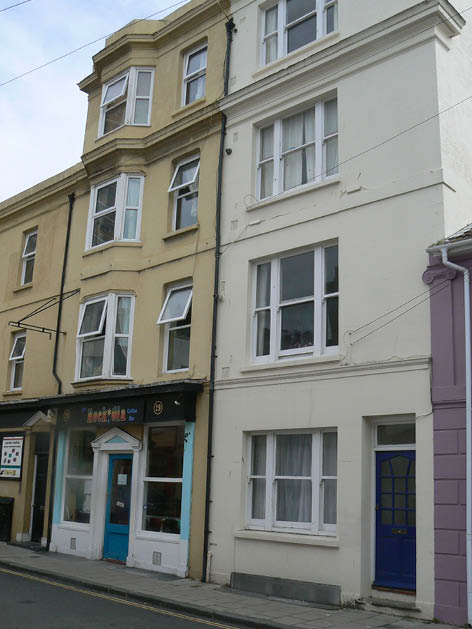
4) Contemporary photograph of 29 Tidy Street. Image
courtesy of Phyllis McDonald
5) Detail from architectual plan for 29 Tidy Street, 1873.
Image courtesy of East Sussex Record Office. Enlarge
Who was J Fisk? The 1881 Census shows a James Fisk who was a Grocer and Wine Merchant (Master). He lived at 24 and 25 Trafalgar Street; Brighton. Nos. 24 and 25 are on the corner of Trafalgar and Tidy Street (currently they are the Wax Factor and R.J.Fashions). However, despite the work done there are no residents recorded in the Census Reports for number 29. In the street directories there are no names except for a Thomas Brown in 1897 in the Pike street directory. As his business was adjacent it is possible that James Fisk just used it to extend his storage facilities. Perhaps it was always used as commercial premises, certainly between 1966 and 1973 it was occupied by Stack Pianos.
There were also interesting changes in 1873 to number 19 Tidy Street which was developed into a photographic studio for William Prudden (c. 1842-1922). This involved an extra floor above the usual “back offices” which then extended over the further “offices” with a sloping roof and glazed “head” allowing the maximum amount of northern light.19
There was also a new shop front, in 1896, for number 2 Tidy Street, replacing the original Georgian pattern window with one in Gothic style. This later window can be seen in a 1974 photograph taken by the Borough Surveyor but it is now without its fine gothic detailing, which was likely lost to decay over time.20 The work was to be done for Edmund Pelling, who was a shoemaker who lived at number 5 in 1881 and 1891. In the 1901 Census Edmund Dearing Pelling is living as a boarder “on his own means” in Southover Street.
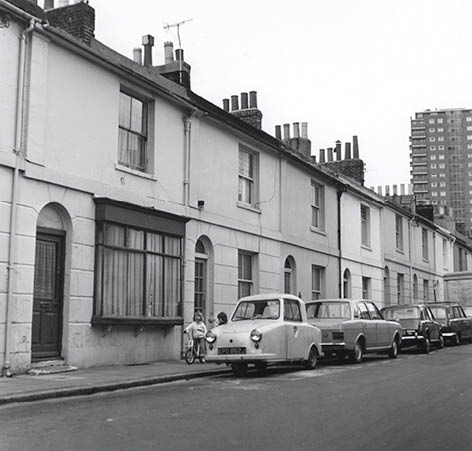
6) Brighton Borough Surveyor’s photograph of 2 Tidy Street,
1974. Image courtesy of the Royal Pavilion, Libraries and
Museums, Brighton and Hove
7) Architectural plan for 2 Tidy Street, 1896. Image courtesy of East Sussex Record Office. Enlarge
Ownership
As there is a lot of information about 4 Tidy Street it will be useful to use this as an example of ownership and tenancy for this street. Although Robert Frampton may have been living in the house he built, Robert Morling was evidently intending to let the property. He also owned other properties. When he died he left number 4 Tidy Street to his daughter Ann Butler and two other properties, 7 and 8 Cambridge Street, to his son. On the 16th April 1850 Ann and James Butler, her husband, took out a loan of £160 from Miss Stella Williams using the title of number 4 as a guarantee. (It is interesting that the Commissioners for Sussex had to interview Ann Butler to ensure that she had agreed to this willingly.)
However, the Butlers did not redeem the loan and on the 2nd April 1853 Stella Williams put the property up for auction, selling it to Edward Chatfield and Sidney McWhinney for £220. In order to buy the property Edward Chatfield took out a mortgage for £197 from the Borough of Brighton Building Society, which he repaid in 1857. Edward Chatfield was also an absentee landlord, (his Will shows him living at 16 Pelham Street) and he continued to use the property as collateral for loans. He borrowed £191.15/- from the Brighton Benefit Building Society in 1858 and £409 in 1872 from the Albert Benefit Building Society. These loans were all paid off in turn and when he died on the 13th Sep 1893 the property was left to his son Ebenezer Chatfield. On the 20th March 1894 Ebenezer sold number 4 to William J Overall who obtained a mortgage of £456.13/6d. from the Second Brighton and District Mutual Benefit Building Society, however it was a short-term loan and was paid off on 25 July 1916. It is interesting that the building society movement appears to have taken over the role from private lenders, although on the 8th March 1915 Mrs Jane Overall borrowed £200 (+ interest of 5%) from Mrs MJ Wheadon using freehold premises number 4 Tidy Street as security.21
While all this was going on the house was let to tenants, who frequently had lodgers living with them. Sometimes there was a complete changeover of personnel between Census Reports, but for over twenty years, between 1861 and the 1880s, the Johnson family occupied number 4. James and Eliza were 22 years old in 1861; he was a labourer and she was a laundress. In 1871 they had two sons and two daughters. In 1881 they had five sons and three daughters; their eldest son, (James, now aged 17) was working as a “printer compositor” while their eldest daughter Amy (aged 15) was an ironer. It is interesting, in view of the alterations noted above, that the Johnson’s shared the house in 1861 and 1871 with Mary Newman who was also a laundress. In 1861 there were nine laundresses living in Tidy Street
In 1891 there was a 29-year-old widow (Clara Elms) with her 6-year-old daughter Edith and her parents, Sidney and Faith Dendy (Sidney was a French polisher). Clara also had a boarder (18 year old Florence Head, a dress maker) and living separately in the house were Emma and Edwin Rondel (he was a tailor.)
Number 4 was less crowded in 1901 when Sarah and Thomas Gander (a cab driver) lived with one boarder. In 1911 they were the only two residents. However Thomas was, by then, no longer a cab driver but a “handchairman” which appears to be a Bath Chair Attendant
Residents
Who were the people who actually lived in these streets? Fortunately the 1841 Census is on hand to enlighten us. Of the ninety-two occupations shown in the Census ten were concerned with the construction industry (e.g. carpenters); eighteen were in domestic service (including two gardeners – although we cannot be sure if any were servants in the houses in which they lived rather than elsewhere); nine were involved in food supply (butchers, grocers etc) and seven in clothing related trades (needlewomen, cordwainers etc) There were also three laundresses, three coachmen, four smiths and fourteen living on “independent means”. They had all been born in Sussex so we can deduce that the initial growth in the area was at least, in part, attributable to importing labour from other parts of the county.
Trade
Most of the street was residential. There were however shops on each corner, mainly fronting Gloucester Lane (Road) and Trafalgar Street. There were also pubs, the Rising Sun at number 23 and the Brazen Star (later the Gasfitters Arms) at number 33.
The Brazen Star
In Folthorpe’s 1859 and 1865 directories number 33 Tidy Street is shown as the Brazen Star but by 1878 it had become the Gas Fitters Arms. There are apparently no records available for the Gasfitters Arms; it closed down between 1919 and 1940.
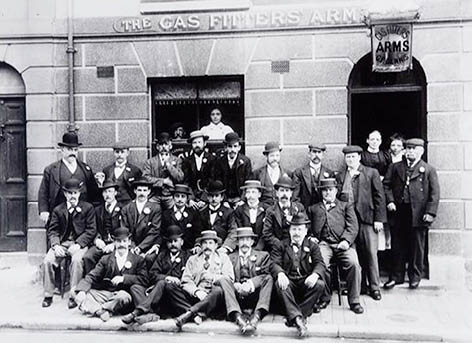
8) The Gas Fitters Arms, Tidy Street. Image courtesy of The
Regency Society. For further details about this photograph,
see: http://www.regencysociety-jamesgray.com
The Rising Sun
The 1845 Kelly’s Directory merely shows Robert Taylor as a beer retailer but by the 1854 number 23 has the name of the Rising Sun. Robert Taylor is not in the 1841 Census and so, as there are no house numbers, we cannot be sure about the family. However the names of what may have been his children do appear (Robert, Mary, William and Thomas) together with Elizabeth Taylor (age 24). Was this a first wife or another relative? Robert Taylor (then aged 39 and his wife Frances, aged 45) and his family were at the Rising Sun in 1851 and stayed there until the 1870s. After his death Frances took over as “publican” in 1871. In the 1881 Census Walter Hollingdale has become the licensed victualler; in 1891 the “publican” was George C. Flowers but by 1901 and in 1911 it was James Harris.
The Rising Sun belonged to the West Street Brewery between 1878 and 1892. The West Street Brewery was owned by Vaillance Catt and Co. In 1899 it was one of the seventy-four properties which Charles W. Catt sold to Tamplins.22 The Rising Sun continued to function, according to Kelly’s Directories until 1970 but had disappeared by 1974.23
Mattress Making
Number 43 looks as though it may have been a coach house or stables and it does appear to have been used for commercial activities. Folthorp’s Directory of 1865 names T. Tickhurst as a coal and wood dealer. In Pages Directory of 1878 it is occupied by F Cook, a Mattress maker, who is still living there in 1888. Between 1906 and 1940 it is occupied by Nellie Price, initially on behalf of Ladbury and Co. but later (after the First World War) the company has become Price and Co. In 1938 they move to Robert Street and in 1945 her nephew sold the company to Norman Stace who added sprung mattress technology to the original use of straw as the filling. Today, the business still exists as Price & Company (Regency) Ltd in Portslade.24
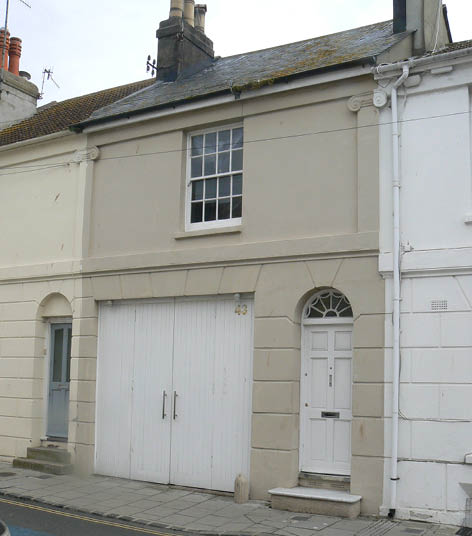
9) Contemporary photograph of 43 Tidy Street, image
courtesy of Phyllis McDonald
Health
In 1911 26 Tidy Street was the home of James Sharp (a furniture porter) with his wife, Fanny, her uncle James Packman (a yardman), his son Jabez William (aged 11, an assistant in a shop) his nephew Harry Mansfield (a draper’s porter) and a boarder (Eric Budd.)
In 1910 Jabez was very ill. He had diphtheria and scarlet fever at the same time and had been treated firstly at the Brighton Sanitorium and then at the Royal Sussex County Hospital for an operation on his throat. He would have been ten years old at the time. We can see that later, from his army record in 1914, he claimed to have had a heart attack which had left him paralysed down his left side, followed by similar attacks in 1915. The effects of this led to him being discharged as unfit for war service in 1915.25
In January 1912 Fanny’s uncle James Packham died very suddenly. He worked for George Lynn (a builder) and every other Saturday would stay and clean at the offices. On Saturday 27th January 1912 George Lynn found him dead and called for both the police and a doctor. The post-mortem found the cause of death to be heart failure due to an enlargement of the heart and incipient pneumonia. At the inquest Fanny revealed that her uncle’s real name was James Soam.26
The Sharp’s also had a daughter, Florence Edith Isabelle, who married Frederick W Fairweather. In August 1912 Florence came to stay with her mother so that she could be in Brighton for her confinement in January 1913. On the night of Wednesday 27th November however, she went into labour. At 3am her mother called out the midwife from the West Street Hospital for Women, who left after giving the opinion that the child would not be born for some time, however, at 7.30am the pains were worse. Her mother sent for the nurses and, when they were not there by 8.05, went to telephone again. At 8.40 she went out to phone again but when she returned found that the child had been born dead. The midwives came immediately after and declared it stillborn. In her evidence Fanny specifically says that she telephoned for the nurses, presumably using the public call box on the corner with Gloucester Road.27
World War One
Several men gave Tidy Street as their address when enlisting for the British army in the First World War, one of them being Jabez Sharp, as previously mentioned, of 26 Tidy Street. Jabez was 5’8 ½” high and his chest girth (expanded) was 35”. He had a pale complexion with brown eyes and hair. As well as his earlier “heart” attacks he had a similar one in January 1915 when billeted in Bexhill. He had gone home to Brighton in May 1915 where he was taken ill and then admitted to the 2nd Eastern Group Hospital on May 29th. His army doctor was skeptical about “heart disease” but diagnosed a “visible cardiac pulse” and a “syphalic [sic] murmur at the apex” along with (slight) “regurgitation at the initial valve.” He was discharged in August 1915 as unfit for war service. 28
Harry Percy Green enrolled from 41 Tidy Street. Harry’s records show that he started in the Sussex Yeomanry when he enlisted in the L. N. Lancs Battn London Regt 1915. This is probably the same Harry Percy Green, a butterman aged 33, who in the 1911 Census was living with his 28 year old wife Violet Edith Leah and his mother-in-law, Leah Harriett Waters, in Guildford Street.29
John Henry Merrin, of 7 Tidy Street, Brighton, was forty-two in 1915 when he was admitted to the Middlesex Regiment. He was enlisted into the Regiment in 1915 and transferred to the Royal Engineers in 1917. He rose to the rank of Lance Corporal but was transferred back to England in April 1918 and then discharged as unfit for war service in June 1818 with a total service of three years and one hundred and six days. In 1919 there was correspondence as to the rate of pay at which he had enlisted. He claimed to have signed-up on the 11th March 1915 at 3/- a day for road making. (In the 1911 Census he lived at 36 Dean Street, Brighton, and he was a foreman roadmaker, hence his claim for expert pay). He did not return to Tidy Street: his discharge papers give his address as 8 Dyke Road, later changed to 41 Kew Road Ridgewood Nr Uckfield. His wife was Alice Maud Merrin (nee Wilding) five children are noted on his records: Albert Edward (b. 1900) Stanley Harold (b. 1902) Ivy Victoria (b. 1906) Edna May (b. 1907) Olive Edith (b. 1910).30
Ernest Charles Skinner, of 38 Tidy Street, was thirty-three when he enlisted in 1915. He was posted as a gunner with the RA (RGA). He was a pork butcher. Ernest was 5’ 7¾” with a chest girth (expanded) of 37” and he weighed 136 lbs. His wife was Ethel Marian (nee Webb) and they had one child Ethel Mary Elizabeth who was born on 5th July 1906. He received the War Medal and Victory Medal. He was finally discharged from the army (without any “disability due to my military service”) 25th January 1919 and transferred to the Army Reserve on the 22nd February.31
Stephen Edward Smith Wood was a grocer’s assistant. When he enlisted in 1916 into the Training Reserve aged eighteen, he gave his address as 22 Tidy Street, Brighton. (His father was H Wood of 4 Railway Street Brighton, which was the address he gave when on leave. In 1918 his furlough address was 93 Preston Road). He was posted to the 3rd Bedfordshire Reg. Landguard on 15th June 191816. In 1922 he received the British War Medal and Victory Medal.32
All of these men survived the carnage of the First World War. James Henry Smith, however, is a mystery. He enlisted in Woolwich on the 26th May 1915. He claimed he was a storeman, aged 35, that he lived at 16 Tidy Street, Brighton, and that his mother, Elizabeth Smith, lived at The Green, Salisbury. We know that he was 5’ 5¾” high, with a girth of 35” and he weighed 141 lbs, but there, our knowledge of him stops. On the 30th May he was found to be missing (AWOL – absent without leave) along with his army ankle boots, woolen underwear, shirt and greatcoat. When the police contacted the current and previous residents of Tidy Street he was not know and a letter to his mother’s address was returned “Unknown”. He was declared a deserter on the 26th June 1915.33
Events
1950-1975 Planning Blight
After the Second World War there were plans to widen Gloucester Road and ‘improve’ the North Laine area. This made it difficult for house owners to sell their houses on the open market and Brighton Borough Corporation was obliged to buy them, under the Town and Country Planning Act 1962. Records of these purchases are held at ESRO.
The earliest record is dated 30th November 1955 when estate agent Eric Marchant wrote asking if the Housing Manager would be authorised to buy number 4. However as the property was let to a controlled tenant (who could not be forced to move) the Corporation decided in May 1956 not to proceed. The property became de-controlled in February 1958 (under the 1957 Rent Act) but there was no further action until November 1963 when the Corporation approved the purchase. The Corporation finally received the keys in July 1964.34
In 1962 the Corporation was offered number 37 Tidy Street and the Borough Surveyor recommended its purchase because it would be affected by the future road scheme; however it was decided not to buy the house.35
In March 1963 the owner’s son-in-law contacted the Corporation about number 3. He understood that it was scheduled for demolition and it would be very difficult for his elderly mother-in-law to continue living there. He and his wife were planning to bring her into an extension which they were building on their bungalow, but needed the income from the sale to do this. The Corporation purchased it in October 1963 for £1,800.00.36
In August 1966 negotiations were under way for number 7 Tidy Street. Initially the Corporation refused to purchase it, but solicitors for the owner served a purchase notice under S139 Town and Country Planning Act 1962. It was purchased by the Corporation in April 1967 for £2,100.37
Negotiations for 44 Tidy Street in 1966 were more complicated. The daughter of the owner wanted to move her elderly parents nearer to her in Surrey. Plans for the Gloucester Road widening would not affect that part of the street, so it was necessary to make a case for hardship, which was successful owing to the ill health of both parents. However although the Corporation purchased the property in February 1967 the Housing Manager refused to use the home for temporary housing because of the costs (over £1,000) to bring it up to an acceptable standard. The Corporation officers were aware that it was undesirable to leave houses boarded up, but there is no indication in the file as to what the final decision was. However in May 1969 the Housing Committee approved the procedure for the fixing of rents and the selection of tenants and considered procedure in connection with the letting of number 44 and other empty properties which had been renovated.38
The story of number 47 Tidy Street dragged on for years. In January 1967 Dutton, Briant and Watts offered the house to the Corporation because sales to cash buyers had fallen through three times due to the Gloucester Road Widening Scheme. It was offered for £1,500 and a handwritten note on the file records that the previous owner’s widow had moved to Newhaven. The Joint Planning Sub-Committee twice refused to purchase it. In August 1967 a notice was served requiring the authority to purchase under the Town and Country Planning Act 1962, Section 139. “as the property has been sterilised we have no alternative but to request the Local Authority to purchase.” However the Town Clerk was obliged to resist this: in view of the amount of time which had elapsed since the widow had vacated the property she no longer qualified as a resident owner-occupier.
This does seem rather harsh and, in fact, the Town Clerk did contact the Minister of Housing and Local Government for permission to purchase (“there can be no doubt that the owner is quite unable to sell the property because of the highway proposals.”) Permission was evidently not forthcoming and negotiations ended with a note in March 1968 from the agent that the vendor had been obliged to sell to a speculator for £750 (as opposed to the £1,500 previously discussed with the Corporation.)
The speculator did not take long to sell on the property. Despite the widening plans he sold it to a lady (she shall be called Miss L) and her brother moving to Brighton from Ramsgate; “It was all we could get in Brighton.” In January 1969 she offered to sell it to the Corporation because it was too big for them and in February the Joint Planning Sub-Committee approved the purchase. In June Miss L accepted the offer of £1,100. The sale was delayed when in the same month she withdrew from the purchase of a house in Steine Gardens. In November she was concerned about the house because damp was coming in, but was told she could not get a grant for a new roof because it was maintenance work. Later that month she had a fall which led to hospital treatment, and the business was left until she was in better health. It was a year later (October 1970) that she informed the Corporation that she and her brother would be returning to Ramsgate where she had put down a deposit on a house. In December the keys were handed over to the Corporation and in July 1971 the property passed to the Housing manager.
However in April 1972 Miss L contacted the Corporation asking if she might be able to buy the house back. She had heard that the houses in Tidy Street were not now to be pulled down. However, as no decision had been made about the Town Centre Plan or the Gloucester Road scheme or the north/south relief road, the Corporation were not prepared to sell; or to allow her to live there as tenant. They were “only prepared to grant a tenancy to a family on the housing waiting list.”39
What was this Gloucester Road Widening Scheme that caused a planning blight for nearly 20 years? The records of this plan are not available at the ESRO. In 1965 Brighton County Borough Corporation (together with ESCC, WSCC and Hove Borough Council) set up a survey team to prepare a town centre map of Brighton in the context of planning proposals for Brighton and the area (ten years after the Corporation first began buying up the properties.)
The final report in 1972 has no reference to any widening of Gloucester Road. Key proposals were an elevated spine road from Trafalgar Street to Bond Street and a bus station in North Street. The elevated road would have passed directly over Tidy Street. As for the area itself, although noting that the houses were now in poor condition the proposals for the area were redevelopment and improvement with an emphasis on traffic-free areas and conservation.40
Thankfully neither the elevated spine road nor the bus station plans were implemented and The North Laine Conservation Area was formed in 1978 thanks to the hard work of Ken Fines and the North Laine Community Association. Attention turned to making the streets and houses of North Laine into the vibrant area it is today.
Today
The street has a great community spirit, every year the residents close off the road and hold a party; it would be fascinating to find out when this tradition started. In March 2011 residents took part in a research project organised by the CHANGE project – a collaborative project run by a number of universities including the University of Sussex - and funded by the Engineering and Physical Sciences Research Council (EPSRC).41 The aim of the project was to see if publicly “displaying the street’s average electricity usage and showing how it compares to households in different places in the UK and other countries change the community’s electricity consumption during the project?” 42
The project involved the residents of Tidy Street recording their electricity usage; the results were then displayed on the street (the remnants of which can still be seen, as markings, on the road.)
Conclusion
From its humble beginnings as farmland, Tidy Street, having managed to survive destruction, has become an extremely desirable Brighton address, and as can been seen from this document, one possessing an interesting history, albeit with much still to be discovered.
In the middle of a busy city, located close to a mainline train station and surrounded by the hustle and bustle of modern life, it is easy to walk past and miss the value of Tidy Street and its neighbours. Yet, without these streets the railway would have had no workers, and the growing town of Brighton no servants. These streets were vital cogs in the town’s development and without them it would have struggled to have flourished into the thriving seaside resort it became.
References
- ESRO, 4 Tidy Street, Brighton. Deeds, abstracts of title, mortgages etc 1835-1914 HOW/63/2
- West Sussex Record Office Abstract of title of Nathaniel Hall. ADD MSS/47,110 1829 http://www.nationalarchives.gov.uk/a2a/records.aspx?cat=182-penny&cid=1-... tidy#1-2-7 (Accessed 04 August 2011)
- Carder, Timothy. The Encyclopaedia of Brighton, Section 112,C East Sussex County Libraries, 1990
- Town Commissioners, My Brighton and Hove. http://www.mybrightonandhove.org.uk/page_id__8907_path__0p1364p1013p1395... (Accessed 04 August 2011)
- Timothy Carder, The Encyclopaedia of Brighton, section 127, East Sussex County Libraries, 1990
- ESRO: 101 Gloucester Road, Brighton AMS6610/5/1-12 [1823]-1883 http://www.nationalarchives.gov.uk/a2a/records.aspx?cat=179-amsff&cid=10... street#10-5 (Accessed 04 August 2011)
- ESRO, HOW/63/2, 4 Tidy Street, Brighton. Deeds, abstracts of title, mortgages etc 1835-1914
- ESRO. Commissioners Minute Book, 1836-1838 DB/B60/6
- Dale, Antony. Brighton Town and Brighton People, Phillimore, 1976
- Timothy Carder, The Encyclopaedia of Brighton, section 200, East Sussex County Libraries, 1990
- Dale, Antony. Brighton Town and Brighton People, Phillimore, 1976
- Dale, Antony. Brighton Town and Brighton People, Phillimore, 1976
- Pike’s Directory of Brighton 1912, page 173
- ESRO No 4 Tidy Street June 1 1870 DB/D8/965
- ESRO No 4 Tidy Street June 1 1870 DB/D8/965
- ESRO No 16 Tidy Street June 27th 1882 DB/D8/2258
- Proposed additions to back office of no.12 Tidy Street for Mr Sattin Feb 19th 1889. DB/D8/3111
- ESRO Proposed additions to Mr J Fisks’s premises in Tidy Street Brighton. DB/D8/1287
- ESRO Plan of new photographic studio at no 19 Tidy Street April 15 1873. DB/D8/1243
- ESRO No.2 Tidy Street Sept 1896
- ESRO, HOW/63/2. 4 Tidy Street, Brighton. Deeds, abstracts of title, mortgages etc 1835-1914
- ESRO Tamplins Breweries TAM/1/31/1-2
- Kelly’s Directory of Brighton 1970
- http://www.price-regency.co.uk/info/background.htm (Accessed 12 July 2011)
- http://search.ancestry.co.uk/cgi-bin/sse.dll?rank=1&new=1&MSAV=1&msT=1&g... (Accessed 13 July 2011)
- ESRO SOAM COR/3/2/1912/17, 29 Jan 1912
- ESRO FAIRWEATHER COR/3/2/1912/138, 29 Nov 1912
- http://search.ancestry.co.uk/cgi-bin/sse.dll?rank=1&new=1&MSAV=1&msT=1&g...
- http://search.ancestry.co.uk/cgi-bin/sse.dll?rank=1&new=1&MSAV=1&msT=1&g... (Accessed 13 July 2011)
- http://search.ancestry.co.uk/cgi-bin/sse.dll?rank=1&new=1&MSAV=1&msT=1&g... (Accessed 13 July 2011)
- http://search.ancestry.co.uk/cgi-bin/sse.dll?rank=1&new=1&MSAV=1&msT=1&g... (Accessed 13 July 2011)
- http://search.ancestry.co.uk/cgi-bin/sse.dll?rank=1&new=1&MSAV=1&msT=1&g... (Accessed 13 July 2011)
- http://search.ancestry.co.uk/cgi-bin/sse.dll?rank=1&new=1&MSAV=1&msT=1&g... (Accessed 13 July 2011)
- ESRO 4 Tidy Street DB/A1/544
- ESRO 37 Tidy Street DA/A1/859
- ESRO 3 Tidy Street DB/A1/539
- ESRO 3 Tidy Street DB/A1/539
- ESRO 44 Tidy Street DB/A1/550
- ESRO 47 Tidy Street DA/A1/551
- Brighton Central Area Study: Final Report: October 1972 Hugh Wilson and Lewis Womersley in association with Drivers Jonas
- changeproject.info/index (Accessed 24 August 2011)
- www.tidystreet.org (Accessed 24 August 2011)

